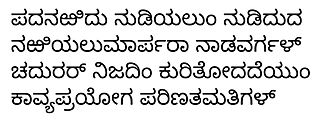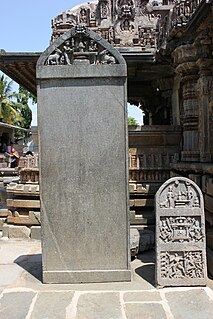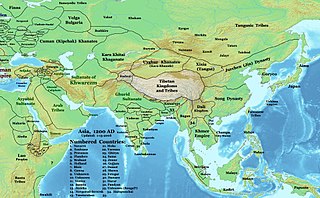Related Research Articles

Kannada literature is the corpus of written forms of the Kannada language, a member of the Dravidian family spoken mainly in the Indian state of Karnataka and written in the Kannada script.

Kavirajamarga is the earliest available work on rhetoric, poetics and grammar in the Kannada language. It was inspired by or written in part by the famous Rashtrakuta King Amoghavarsha I, and some historians claim it is based partly on the Sanskrit text Kavyadarsha. Some historians believe Kavirajamarga may have been co-authored by a poet in the king's court, the Kannada language theorist Sri Vijaya.
Ponna (c. 945) was a noted Kannada poet in the court of Rashtrakuta Dynasty king Krishna III (r.939–968 CE). The emperor honoured Ponna with the title "emperor among poets" (Kavichakravarthi) for his domination of the Kannada literary circles of the time, and the title "imperial poet of two languages" for his command over Sanskrit as well. Ponna is often considered one among the "three gems of Kannada literature" for ushering it in full panoply. According to the scholar R. Narasimhacharya, Ponna is known to have claimed superiority over all the poets of the time. According to scholars Nilakanta Shastri and E.P. Rice, Ponna belonged to Vengibisaya in Kammanadu,Andhra Pradesh, but later migrated to Manyakheta, the Rashtrakuta capital, after his conversion to the Jainism.

Janna was one of the well-known Kannada poets of the early 13th century who also served in the capacity of a minister and a builder of temples. He graced the court of Hoysala empire King Veera Ballala II and earned the title Kavichakravarthi. His noteworthy writings include Yashodhara Charitre (c.1209) which deals with Jain tenets, Ananthnatha Purana (c.1230) which deals with the teachings of the 14th Jain tirthankara, Anantanatha and a short piece called Anubhava Mukura. Although all his works are known for the grace and style, Yashodhara Charite is his magnum opus and one of the classics of Kannada literature.

Hoysala literature is the large body of literature in the Kannada and Sanskrit languages produced by the Hoysala Empire (1025–1343) in what is now southern India. The empire was established by Nripa Kama II, came into political prominence during the rule of King Vishnuvardhana (1108–1152), and declined gradually after its defeat by the Khalji dynasty invaders in 1311.

A large body of Western Chalukya literature in the Kannada language was produced during the reign of the Western Chalukya Empire in what is now southern India. This dynasty, which ruled most of the western Deccan in South India, is sometimes called the Kalyani Chalukya Dynasty after its royal capital at Kalyani, and sometimes called the Later Chalukya Dynasty for its theoretical relationship to the 6th-century Chalukya dynasty of Badami. For a brief period (1162–1183), the Kalachuris of Kalyani, a dynasty of kings who had earlier migrated to the Karnataka region from central India and served as vassals for several generations, exploited the growing weakness of their overlords and annexed the Kalyani. Around 1183, the last Chalukya scion, Someshvara IV, overthrew the Kalachuris to regain control of the royal city. But his efforts were in vain, as other prominent Chalukya vassals in the Deccan, the Hoysalas, the Kakatiyas and the Seunas destroyed the remnants of the Chalukya power.
Chamarasa was a 15th century Virashaiva poet in the Kannada language, during the reign of Vijayanagar Empire, a powerful empire in Southern India during 14th - 16th centuries. A contemporary and competitor to a noted Brahmin Kannada poet Kumara Vyasa, Chamarasa was patronised by King Deva Raya II. The work is in 25 chapters (gatis) comprising 1111 six-line verses (shatpadi).
Rudrabhatta was an influential 12th-century Kannada poet in the court of the Hoysala Empire King Veera Ballala II(r.1173–1220 CE). According to Kannada language expert Narasimhacharya, the poet was also patronized by a minister of the King. The literary critic Mukherjee feels that after a century of literary revolution caused by the Veerashaiva poets, a benevolent atmosphere created by the king may have encouraged this Vaishnava writer and poet.

Rashtrakuta literature is the body of work created during the rule of the Rastrakutas of Manyakheta, a dynasty that ruled the southern and central parts of the Deccan, India between the 8th and 10th centuries. The period of their rule was an important time in the history of South Indian literature in general and Kannada literature in particular. This era was practically the end of classical Prakrit and Sanskrit writings when a whole wealth of topics were available to be written in Kannada. Some of Kannada's most famous poets graced the courts of the Rashtrakuta kings. Court poets and royalty created eminent works in Kannada and Sanskrit, that spanned such literary forms as prose, poetry, rhetoric, epics and grammar. Famous scholars even wrote on secular subjects such as mathematics. Rashtrakuta inscriptions were also written in expressive and poetic Kannada and Sanskrit, rather than plain documentary prose.
Medieval Kannada literature covered a wide range of subjects and genres which can broadly be classified under the Jain, Virashaiva, Vaishnava and secular traditions. These include writings from the 7th century rise of the Badami Chalukya empire to the 16th century, coinciding with the decline of Vijayanagara Empire. The earliest known literary works until about the 12th century CE were mostly authored by the Jainas along with a few works by Virashaivas and Brahmins and hence this period is called the age of Jain literature,. The 13th century CE, to the 15th century CE, saw the emergence of numerous Virashaiva and Brahminical writers with a proportional decline in Jain literary works. Thereafter, Virashaiva and Brahmin writers have dominated the Kannada literary tradition. Some of the earliest metres used by Jain writers prior to 9th century include the chattana, bedande and the melvadu metres, writings in which have not been discovered but are known from references made to them in later centuries. Popular metres from the 9th century onwards when Kannada literature is available are the champu-kavyas or just champu, vachanasangatya, shatpadi, ragale, tripadi, and kavya.

Mysore literature in Kannada is a body of literature composed in the Kannada language in the historical Kingdom of Mysore in Southern India and written in the Kannada script. The writings date from the Kingdom of Mysore, which existed from around 1600 CE until the establishment of modern India in 1947. Many of the works of this literature written on religious themes are labeled Veerashaiva or Vaishnava in acknowledgment of the two faiths that gave form to the literature and fostered it until the advent of the modern era. Despite a gradual decline in the popularity of Jainism, authors devoted to the faith produced some works of merit. Secular themes dealing with a wide range of subjects were also written on. Kannada literature flourished for a short while in the court of the neighbouring kingdom of the Nayakas of Keladi whose territory was annexed by Mysore in 1763.

Vijayanagara literature in Kannada is the body of literature composed in the Kannada language of South India during the ascendancy of the Vijayanagara Empire which lasted from the 14th through the 16th century. The Vijayanagara empire was established in 1336 by Harihara I and his brother Bukka Raya I. Although it lasted until 1664, its power declined after a major military defeat by the Shahi Sultanates in the battle of Talikota in 1565. The empire is named after its capital city Vijayanagara, whose ruins surround modern Hampi, now a World Heritage Site in Karnataka.
Extinct Kannada literature is a body of literature of the Kannada language dating from the period preceding the first extant work, Kavirajamarga.

Raghavanka was a noted Kannada writer and a poet in the Hoysala court who flourished in the late 12th to early 13th century. Raghavanka is credited for popularizing the use of the native shatpadi metre in Kannada literature. Harishchandra Kavya, in shatpadi metre, is known to have been written with an interpretation unlike any other on the life of King Harishchandra is well known and is considered one of the important classics of Kannada language. He was a nephew and protégé of the noted Early 12-century Kannada poet Harihara. Although the shatpadi metre tradition existed in Kannada literature prior to Raghavanka, Raghavanka inspired the usage of the flexible metre for generations of poets, both Shaiva and Vaishnava to come.
Harihara was a noted Kannada poet and writer in the 12th century. A native of Halebidu in modern Hassan district, he came from a family of accountants (Karnikas) and initially served in that capacity in the court of Hoysala King Narasimha I. Later, he moved to Hampi and authored many landmark classics. Among his important writings, the Girijakalyana written in champu metre is considered one of the enduring classics of Kannada language.
Andayya was a notable 13th-century Kannada writer during the rule of the Hoysala empire. Andayya was a Jain by faith and came from a family of accountants. His most important extant work is the Kabbigara Kava which also goes by the names Sobagina Suggi, Madana Vijaya or Kavana Gella and was written in the 1217–1235 CE period.

Lakshmisa was a noted Kannada language writer who lived during the mid-16th or late 17th century. His most important writing, Jaimini Bharata is a version of the Hindu epic Mahabharata. The writing focuses on the events following the battle of Indraprastha between the Pandavas and Kauravas, using the Ashvamedha conducted by Yudhishthira as the topic of the epic narrative. The writing is in the shatpadi metre and was inspired by the Sanskrit original written by sage Jaimini.
Palkuriki Somanatha was one of the most noted Telugu language writers of the 12th or 13th century. He was also an accomplished writer in the Kannada and Sanskrit languages and penned several classics in those languages. He was a Lingayat a follower of the 12th century social reformer Basava and his writings were primarily intended to propagate this faith. He was a well acclaimed Shaiva poet.
Nagachandra or Abhinava Pampa was a 12th-century poet in the Kannada language.
References
- Ashton & Christie, Martha Bush & Bruce (1977) [1977]. "History of Yakshagana". Yakshagana. Abhinav Publications. ISBN 81-7017-047-8.
- Das, Sisir Kumar (1995) [1995]. "Phases of Indian Poetry". A History Of Indian Literature 1911–1956. Sahitya Akademi. ISBN 81-7201-798-7.
- Guttal, Vijaya (2006) [2006]. "Translation and Performance of Shakespeare in Kannada". In Poonam Trivedi; Dennis Bartholomeusz (eds.). India's Shakespeare:Translation, Interpretation, and Performance. Pearson Education India. ISBN 81-7758-131-7.
- Hart, George L (1976) [1976]. "Later Tamil, Other Dravidian Languages and Sanskrit". A History of Indian Literature-The Relation Between Tamil and Classical Sanskrit Literature. Otto Harrassowitz Verlag. ISBN 3447017856.
- Kamath, Suryanath U. (2001) [1980]. A concise history of Karnataka : from pre-historic times to the present. Bangalore: Jupiter books. LCCN 80905179. OCLC 7796041.
- Karanth, Kota Shivarama (1997) [1997]. "Playwrights and Plays". Yakṣagāna. Abhinav Publications. ISBN 81-7017-357-4.
- Krishnamoorthy & Mukhopadhyay, K, Satkari (1991) [1991]. A Critical Inventory of Rāmāyaṇa Studies in the World: Indian languages and English. Sahitya Akademi. ISBN 81-7201-100-8.
- Mukherjee, Sujit (1999) [1999]. Dictionary of Indian Literature, One: Beginnings - 1850. New Delhi: Orient Blackswan. ISBN 81-250 1453 5.
- Murthy, K. Narasimha (1992). "Modern Kannada Literature". In George K.M (ed.). Modern Indian Literature:An Anthology:Survey of Poems – Vol 1. Sahitya Akademi. ISBN 81-7201-324-8.
- Murthy, A.V. Narasimha (2008) [2008]. Lalanji Gopal; V.C.Srivastava (eds.). History of Agriculture in India, Up to C. 1200 A.D., vol 5, Part1. New Delhi: Concept Publishing Company. ISBN 978-81-8069-521-6.
- Narasimhacharya, R (1988) [1988]. History of Kannada Literature. New Delhi: Asian Educational Services. ISBN 81-206-0303-6.
- Prashad, K Kehsavan (2001) [2001]. Male Madeshwara: A Kannada Oral Epic. New Delhi: Sahitya Akademi. ISBN 81-260-0925-X.
- Rice, E.P. (1982) [1921]. A History of Kanarese Literature. New Delhi: Asian Educational Services. ISBN 81-206-0063-0.
- Rao, Seetharamiah & Marulasiddapa, Sheshagiri L.S., M.V & K (1988) [1988]. Amaresh Datta (ed.). Encyclopaedia of Indian literature – vol 2. Sahitya Akademi. ISBN 81-260-1194-7.
- Rao, Seshagiri L.S. (1988) [1988]. Amaresh Datta (ed.). Encyclopaedia of Indian literature – vol 2. Sahitya Akademi. ISBN 81-260-1194-7.
- Rawat, Hemant (2011) [2011]. Dalit and Backward Women. New Delhi: Lakshay Publishing. ISBN 978-81-87818-94-6.
- Sastri, K.A. Nilakanta (2002) [1955]. A history of South India from prehistoric times to the fall of Vijayanagar. New Delhi: Indian Branch, Oxford University Press. ISBN 0-19-560686-8.
- Shiva Prakash, H.S. (1997). "Kannada". In Ayyappapanicker (ed.). Medieval Indian Literature:An Anthology. Sahitya Akademi. ISBN 81-260-0365-0.
- Srinivasan, P.S. (1992) [1992]. Mohan Lal (ed.). Encyclopaedia of Indian literature – vol 5. Sahitya Akademi. ISBN 81-260-1221-8.
- Sridhar, S.N. (2009) [2009]. "Kannada". In Keith Brown; Sarah Oglivie (eds.). Concise Encyclopedia of Languages of the World. Elsevier. ISBN 978-0-08-08777-47.
- Sadarangani, Neeti M (2004). Bhakti Poetry in Medieval India: Its Inception, Cultural Encounter and Impact. Sarup & Sons, New Delhi. ISBN 81-7625-436-3.
- Thielemann, Selina (2002). Divine Service and the Performing Arts in India. APH Publishing. ISBN 81-7648-333-8.
- Verlag, Harrossowitz (2006) [2006]. "The Bassel Mission in Mangalore:Historical and Social Context". In Reinhard Wendh (ed.). An Indian to the Indians:On the Initial Failure and the Posthumous Success of the Missionary Ferdinand Kittel (1832-1903). Otto Harrossowitz GmbH Ltd. ISBN 978-3-447-05161-3.
- Zydenbos, R (2012). Cushman S; Cavanagh C; Ramazani J; Rouzer P (eds.). The Princeton Encyclopedia of Poetry and Poetics: Fourth Edition. Princeton: Princeton University Press. ISBN 978-0-691-15491-6.